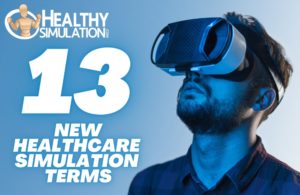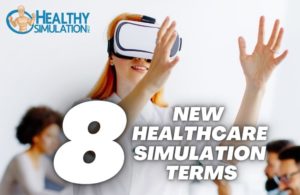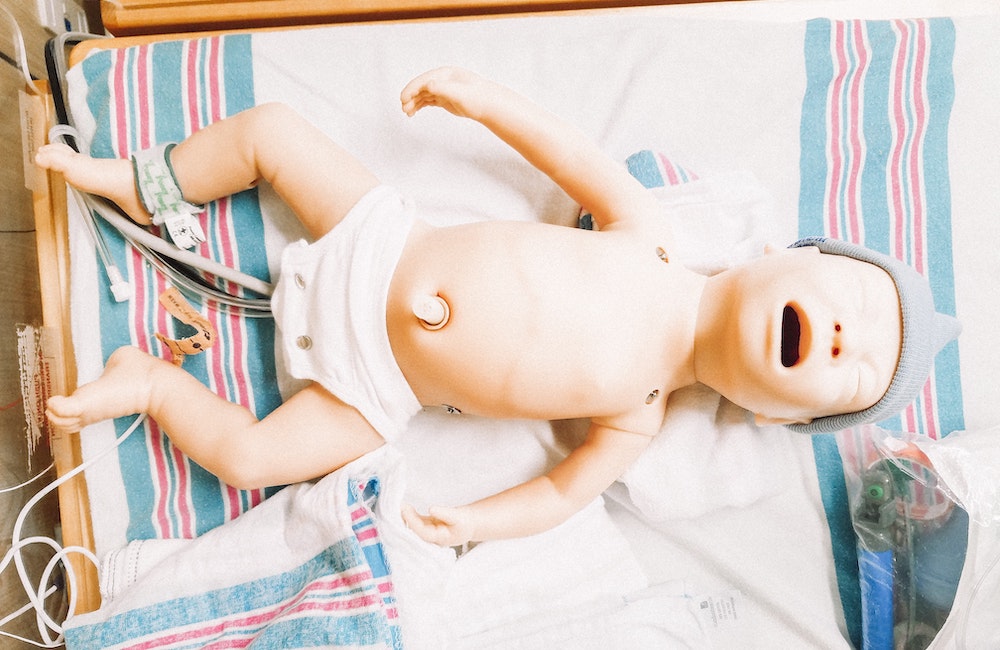Childbirth Simulator
A childbirth simulator, or labor and delivery simulator, is a healthcare simulation manikin or skills task trainer used in medical education to help learners practice the process of obstetric care from prenatal assessment through labor and delivery. A childbirth simulator can be a torso-based task trainer, or a mid- to high-fidelity full-body labor manikin with a simulated uterus, fetus, and placenta. Research demonstrates that using labor simulation in clinical obstetrics training improves patient outcomes and safety.
Clinical simulation training improves patient management skills associated with normal maternal interventions, such as vaginal delivery, as well as obstetrical emergencies, including shoulder dystocia (when the baby’s shoulder becomes stuck on the mother’s pubic bone), eclampsia (maternal high blood pressure), and maternal hemorrhage. Labor and delivery scenarios are often interprofessional, as many healthcare departments can be a part of labor and delivery, including emergency rooms, midwives, labor and delivery nurses, obstetricians, and pediatric departments.
Learners who use a manikin-based maternity simulator, and whose education includes team communication development and critical thinking exercises, demonstrate increased mastery and more confidence in routine deliveries. Birthing simulation training in vaginal delivery offers obstetrical students a realistic yet risk-free environment to gain clinical experience in labor and delivery. Childbirth simulation fosters learners’ comfort, confidence, and proficiency with childbirth procedures. Healthcare simulation trainees enter their fields with higher degrees of clinical competency and skills, which enhance patient safety and reduce maternal morbidity. Here are examples of labor and delivery simulators by various vendors:
Sponsored Content:
CAE Healthcare
CAE Lucina Childbirth Simulator: CAE Lucina is a wireless patient simulator that allows clinicians to practice pre-partum assessment, labor and delivery, emergency care and transport. Lucina responds automatically to obstetric maneuvers and clinical interventions because of its physiology, which has been integrated with fetal physiology. Lucina offers complete training in shoulder dystocia management and supports mechanical ventilation. With the addition of the Female Patient Module, Lucina easily transforms into a non-gravid patient for the practice of emergency scenarios.
Obstetric Susie Childbirth Skills Trainer: This torso task trainer allows learners to practice routine and complicated delivery techniques. The skills trainer’s lifelike features ensure participants can get hands-on practice to develop the skills needed to provide safe and effective care during high-risk/low-frequency labor-and-delivery events.
Sponsored Content:
NOELLE Maternal Care Simulator: The Noelle simulator provides learners with a complete birthing simulation experience, with opportunities to practice providing care before, during, and after delivery. Instructors can use Noelle to demonstrate and have learners practice capabilities in ALS, obstetrics, and neonatal resuscitation protocols.
Victoria Advanced Obstetric Patient Simulator: This high-fidelity manikin is more than a childbirth simulator, offering a comprehensive range of obstetrical events and non-gravid scenarios for general nursing care. Victoria gives instructors a complete healthcare simulation solution that facilitates teamwork and deepens critical thinking skills in learners of all levels.
MamaNatalie: This is a low-tech task trainer that still ensures learners get the appropriate clinical training for several obstetric outcomes. It is ideal for labor and delivery scenarios with standardized participants, as it is able to enhance realism, especially in scenarios involving postpartum hemorrhage. Training with MamaNatalie allows learners to practice uterine massage and placental evaluation. Research has shown that this trainer reduces postpartum hemorrhage and blood transfusion rates.
PROMPT Flex Birthing Simulator: The PROMPT Flex childbirth simulator is another torso-based task trainer that learners can train on to improve patient safety initiatives being implemented in many labor and delivery departments. These initiatives are aimed at addressing the potential for adverse events and medical errors.
MamaBirthie: MamaBirthie is a wearable task trainer that can be used during in-situ team clinical simulations or as a tabletop model for demonstrations. Cost-effective and easy to set up, learners can practice abdominal and vaginal examinations, normal birth, breech delivery, shoulder dystocia, or vacuum-assisted delivery. Combine MamaBirthie with SimMom® for a complete and impactful healthcare simulation toolkit. SimMom is a full-body simulator that provides opportunities for enhanced training with cross-functional teams to work collaboratively on high-risk, low-frequency events, as well as normal vaginal delivery. Other O/B simulators are available from Limbs & Things, Pocket Nurse, MedVision, Nasco Healthcare, and more. See our complete list of healthcare simulation simulation vendors for more!
Labor and Delivery Simulation Scenarios
According to the Centers for Disease Control and Prevention, in 2018 the infant mortality rate in the United States was 5.7 deaths per 1,000 live births. The maternal mortality rate, which is when a woman dies during pregnancy, at delivery, or soon after delivery, because of complications, is about 700 women annually in the United States.
Childbirth simulation provides an opportunity for individual healthcare members and teams to practice care of a mother and her newborn without any risk of harm to a mother or baby. Learners practice making independent decisions in a variety of real-life situations. Childbirth simulators can help instructors demonstrate labor problems, high-risk deliveries and postpartum emergencies. For example, simulators can mimic the woman who labors for hours or who has comorbidities such as diabetes or eclampsia. Delivery can be programmed to present with complications such as shoulder dystocia, babies with low Apgar scores and placenta abnormalities. The timing of the birth and opening of the cervix can be altered to create various case studies.
Many potentially serious events associated with childbirth do not occur very often and therefore, staff get little chance to become efficient in responding to such emergencies. Ob-gyn simulation provides the opportunity for skills training and allows obstetricians, midwives, nurses and other healthcare personnel to practice critical events and save lives. These childbirth simulators also provide real-life experiences for teams to practice communication and team interactions. Failure to communicate is one of the leading causes of medical errors.
The Agency for Healthcare Research and Quality (AHRQ) provides a number of specialty labor and delivery simulation scenarios that utilize TeamSTEPPS, an evidence-based set of teamwork tools. The ob/gyn simulation scenarios emphasize the importance of clear communications on the healthcare team so that maternal and fetal outcomes are optimal. The scenarios incorporate the induction of labor, emergent c-section, communications regarding medication, patient hand-off and postpartum hemorrhage, among other birthing scenarios.
The Center for Healthcare Education and Simulation (CHES) provides birthing scenario classes using the Gaumard NOELLE Manikin. These clinical simulations include normal labor and delivery, Cesarean-section delivery, preterm breech delivery, cord prolapse, neonatal cardiac arrest, pregnancy-induced hypertension (eclampsia), and postpartum hemorrhage.
Childbirth Simulator Simulation Education Latest News

13 Medical Simulation Keywords You Need to Know About

8 Medical Simulation Keywords You Need to Know About
Sponsored Content:














